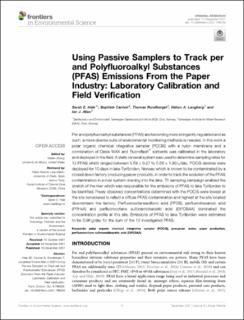Using Passive Samplers to Track per and Polyfluoroalkyl Substances (PFAS) Emissions From the Paper Industry: Laboratory Calibration and Field Verification
Peer reviewed, Journal article
Published version
Permanent lenke
https://hdl.handle.net/11250/2978584Utgivelsesdato
2021Metadata
Vis full innførselSamlinger
- NGI articles [1061]
Sammendrag
Per and polyfluoroalkyl substances (PFAS) are becoming more stringently regulated and as such, a more diverse suite of environmental monitoring methods is needed. In this work a polar organic chemical integrative sampler (POCIS) with a nylon membrane and a combination of Oasis WAX and Fluoroflash® sorbents was calibrated in the laboratory and deployed in the field. A static renewal system was used to determine sampling rates for 12 PFAS which ranged between 0.69 ± 0.27 to 5.68 ± 1.80 L/day. POCIS devices were deployed for 10 days in lake Tyrifjorden, Norway which is known to be contaminated by a closed down factory producing paper products, in order to track the evolution of the PFAS contamination in a river system draining into the lake. Th sampling campaign enabled the stretch of the river which was responsible for the emissions of PFAS to lake Tyrifjorden to be identified. Freely dissolved concentrations determined with the POCIS were lowest at the site considered to reflect a diffuse PFAS contamination and highest at the site located downstream the factory. Perfluorooctanesulfonic acid (PFOS), perfluorohexanoic acid (PFHxA) and perfluorooctane sulfonamidoacetic acid (EtFOSAA) dominated the concentration profile at this site. Emissions of PFAS to lake Tyrifjorden were estimated to be 3.96 g/day for the sum of the 12 investigated PFAS.
